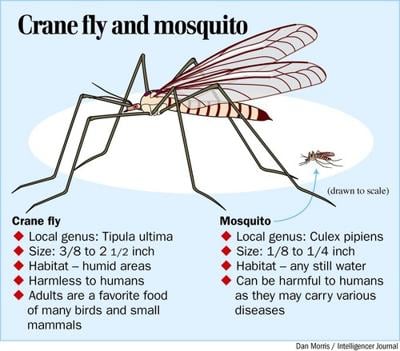Well, maybe not a plague, but there are a lot of them around this fall, according to Josh Fair, coordinator of the countys West Nile virus program.
Residents apparently are mistaking the bugs, which look like giant mosquitoes, for their blood-sucking, virus-carrying cousins.
We always get calls from people about crane flies this time of year, Fair said. But this year were getting way more than usual.
The message Fair would like to spread is that if you see a mosquito thats too big to stand on a dime, then youre probably looking at a crane fly, which poses no threat to humans.
Theres no need to worry, Fair said. They are not vectors for any diseases.
In fact, if youre worried about mosquitoes, crane flies are good to have around because they sometimes eat mosquitoes — hence the origin of one of their nicknames, mosquito hawks.
The crane fly is North Americas largest fly.
They look nearly identical to mosquitoes, except they are much, much bigger.
According to Fair, crane flies are found in aquatic, semi-aquatic and terrestrial habitats.
That means theyre found pretty much everywhere, he said.
Spring and fall are the primary seasons when crane flies appear.
Thats when they transform from larvae into flies to breed.
Fair said Lancaster County typically sees a good number of crane flies each fall, but the insects seem to be especially abundant this year.
You could walk through your backyard and kick up thousands of them, he said. Theyre really thick this year.
Fair could not explain why theres a proliferation of the flies this year.
But judging by the calls his office has received, Fair said he isnt the only one who has noticed this years abundant crop of crane flies.
Weve been getting like three or four calls a day since the middle of September, Fair said.
Most callers are residents concerned about the safety of their families and pets, Fair said.
They want to make sure theres no danger of West Nile virus, which is carried and transmitted to humans by mosquitoes.
They just want to know if theres any danger, he said. We tell them theyre basically human-friendly.
Like mosquitoes, the crane flies should disappear after the first hard frost, Fair said.
According to AccuWeather.com, that frost could come this weekend, when nighttime lows in the 30s are predicted.
West Nile virus can take up to two weeks from the time an infected mosquito bites until symptoms appear.
Typically, the symptoms are similar to the flu, including fever, headache, body aches, swollen lymph glands and, occasionally, a rash on the trunk.
Severe cases may cause tremors, high fever, convulsions, muscle weakness, paralysis, coma or disorientation.
According to the Centers for Disease Control and Prevention, only about one person in 150 who contracts the virus will experience extreme symptoms.
Those most likely to be sidelined with a severe case are people over 50 and those with compromised health conditions, such as transplant patients.
There was one confirmed human case of West Nile virus in the county this year, according to the state Department of Health.
A 47-year-old man contracted the virus in August and reportedly recovered.
Statewide, there were eight cases, including two deaths.




